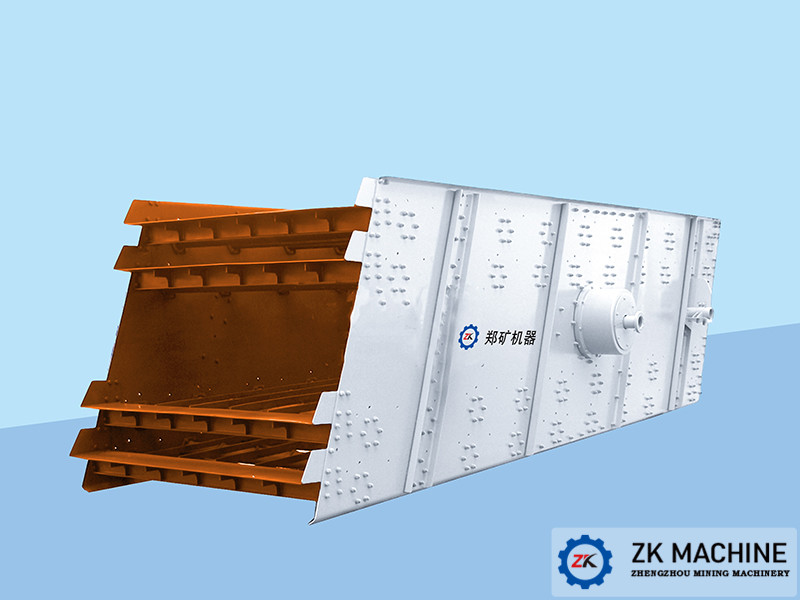Overview of Vibrating Screen
Date:2020-07-29 14:06:45
Author:admin
Views:
138
The vibrating screen works by using the reciprocating vibration generated by the vibrator. The upper rotating weight of the vibrator causes the screen surface to produce plane whirling vibration, while the lower rotating weight causes the screen surface to produce cone-shaped rotary vibration. The combined effect of the vibrator causes the screen surface to produce multi-rotating vibration. Its vibration trajectory is a complicated spatial curve. The curve is projected as a circle on the horizontal plane, and projected as an ellipse on the vertical plane. The amplitude can be changed by adjusting the excitation force of the upper and lower rotating weights. Adjusting the spatial phase angle of the upper and lower weights can change the curve shape of the screen surface movement trajectory and change the movement trajectory of the material on the screen surface.

Vibrating screens are mainly divided into linear vibrating screens, circular vibrating screens, and high-frequency vibrating screens. According to the type of vibrator, the vibrating screen can be divided into single shaft vibrating screen and double shaft vibrating screen. The single-axis vibrating screen uses single unbalanced re-excitation to vibrate the screen box, the screen surface is inclined, and the motion track of the screen box is generally circular or elliptical. The double-shaft vibrating screen is re-excited by double unbalanced synchronous counter-rotation, the screen surface is horizontal or gently inclined, and the motion track of the screen box is a straight line. Vibrating screens include inertial vibrating screens, eccentric vibrating screens, self-centering vibrating screens and electromagnetic vibrating screens.
As a filterable mechanical separation device used for mud solid phase treatment, the vibrating screen is composed of a screen and a vibrator. The thickness of the screen is expressed by mesh. Generally, those with 50 meshes or less are coarse screens, and those with 80 meshes or more are fine screens. The vibrator is an eccentric wheel that rotates under the drive of a motor to vibrate the screen frame. Due to the vibration of the screen frame, when the mud flows on the screen surface, the coarser solid particles remain on the screen surface and are discharged from one end along the inclined plane. The finer solid particles and the mud liquid flow together through the screen holes to the mud pool.
The above picture is an example of a YA series vibrating screen. The eccentricity of the shaft is used as the excitation force to make the screen box move approximately in a circular motion. It has the characteristics of high screening efficiency and large screen weight. Dry classification of various granular and small solid materials in power, light industry and chemical industries. This type of vibrating screen is divided into light type and heavy type according to the purpose, and divided into single layer, double layer and multiple layers according to the screen surface. Various types of screen surfaces such as wire woven mesh, rods, casting, welding, and punching are optional. Its working principle is that the vibration exciter is installed on the side plate of the screen box, and the motor is driven by a belt drive to rotate, causing it to generate centrifugal inertia force, forcing the screen box to produce periodic reciprocating vibration, and its motion track is approximately circular; After the screened material enters the screen surface, due to the vibration of the screen surface, the material layer on the screen surface loosens and jumps away from the screen surface. Small particle materials can fall through the material layer, while large particles cannot penetrate the material layer. The original chaotic particle group has separated, forming a regular arrangement of small particles on the bottom and large particles on the top; the fine particles that reach the screen surface, the ones smaller than the sieve hole, can be screened, and finally the coarse and fine particles are separated and the screening is completed. ; At the same time, the particles stuck in the screen holes will be shaken out to ensure that the screen holes are not blocked. Its characteristics are as follows:
1. The motor and the vibration exciter adopt belt transmission, which runs smoothly and has little impact on the motor;
2. The structure of small amplitude, high frequency, and large inclination angle is adopted, with high screening efficiency and large processing capacity;
3. The screen surface material is wear-resistant, fatigue-resistant and corrosion-resistant, and has high opening rate, light weight and high classification accuracy;
4. The steel coil spring is used as the damping device, which has reliable performance and long service life;
5. The eccentric shaft is used as a vibration exciter, with large excitation force, which can make the material stuck in the screen hole jump out and prevent the screen hole from being blocked;
6. It is flexible to use, and the processing capacity can be controlled by changing the inclination of the screen surface.
7. Belt drive, flexible connection, low vibration and impact;
The above is the description of the vibrating screen. After understanding its principles and characteristics, we can better choose on-demand and achieve precise configuration.

